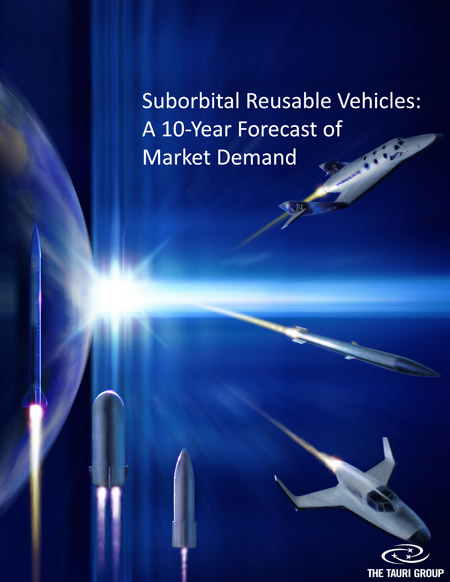A new 102-page study “Suborbital Reusable Vehicles: A 10-Year Forecast of Market Demand” is now available in the NSS website Space Transportation section as a 10 MB PDF file.
Suborbital reusable vehicles (SRVs) are creating a new spaceflight industry. SRVs are commercially developed reusable space vehicles that may carry humans or cargo. The companies developing these vehicles typically target high flight rates and relatively low costs. SRVs capable of carrying humans are in development and planned for operations in the next few years. SRVs that carry cargo are operational now, with more planned.
This study forecasts 10-year demand for SRVs. The goal of this study is to provide information for government and industry decision makers on the emerging SRV market by analyzing dynamics, trends, and areas of uncertainty in eight distinct markets SRVs could address. This study was jointly funded by the Federal Aviation Administration Office of Commercial Space Transportation (FAA/AST) and Space Florida, and conducted by The Tauri Group.
Eleven SRVs are currently in active planning, development, or operation, by six companies. The payload capacity of these SRVs ranges from tens of kilograms to hundreds, with the largest currently planned vehicle capacity at about 700 kilograms. A number of SRVs can carry humans, with current designs for one to six passengers, in addition to one or two crew members in some cases. Some will also launch very small satellites.
The study concludes that demand for suborbital flights is sustained and appears sufficient to support multiple providers. Total baseline demand over 10 years exceeds $600 million in SRV flight revenue, supporting daily flight activity. The baseline reflects predictable demand based on current trends and consumer interest. In the growth scenario, reflecting increased marketing, demonstrated research successes, increasing awareness, and greater consumer uptake, multiple flights per day generate $1.6 billion in revenue over 10 years. In a constrained scenario, where consumer and enterprise spending drop relative to today’s trends, multiple weekly flights generate about $300 million over 10 years. Further potential could be realized through price reductions and unpredictable achievements such as major research discoveries, the identification of new commercial applications, the emergence of global brand value, and new government (especially military) uses for SRVs.



















